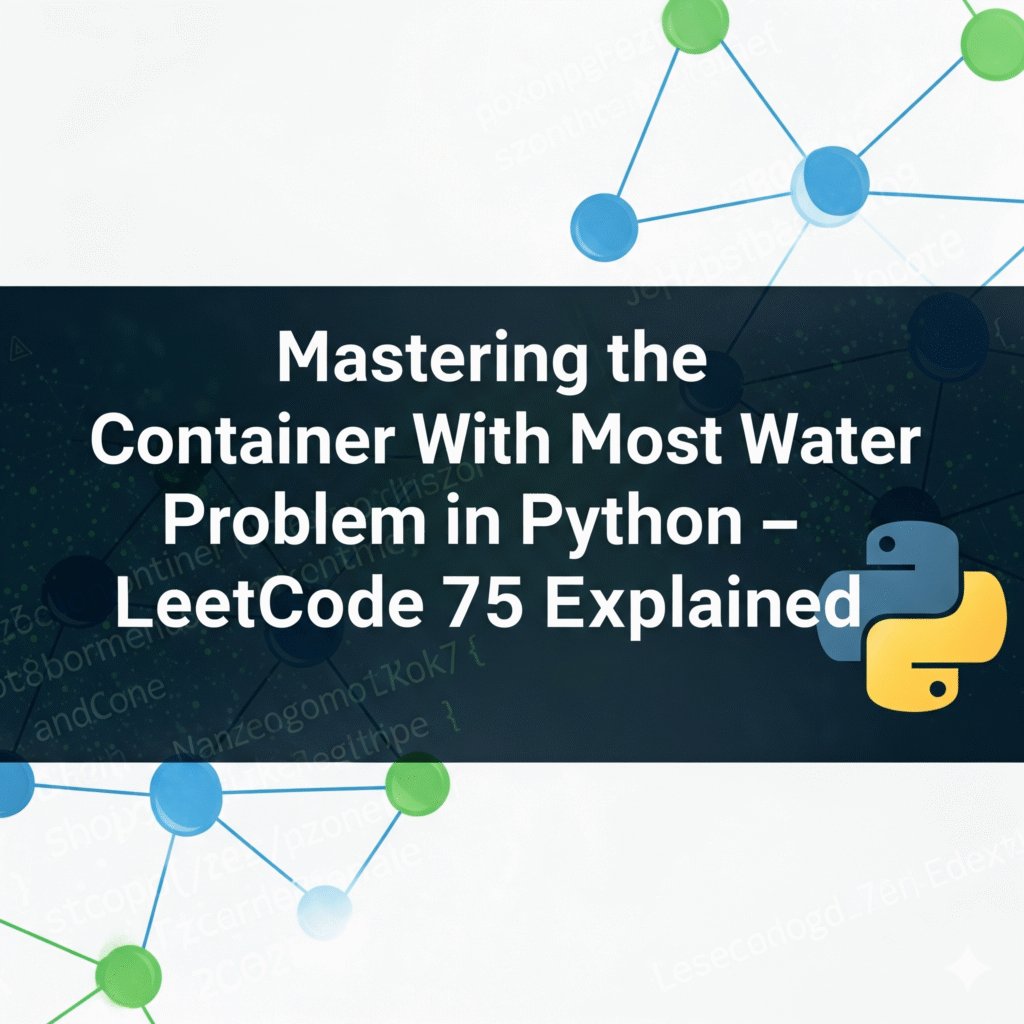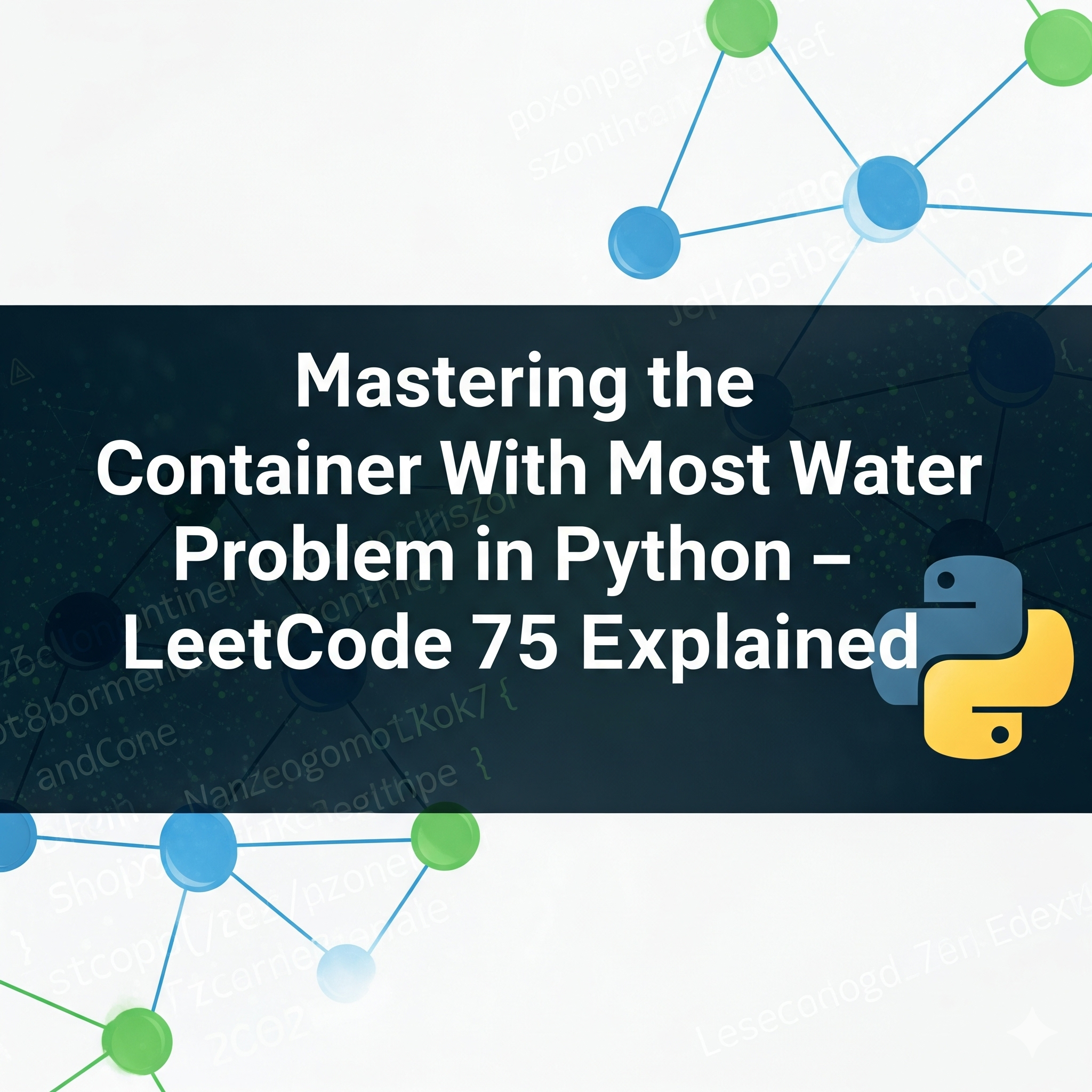The Container With Most Water problem from LeetCode 75 is a classic coding interview question that tests your understanding of two-pointer techniques, greedy strategies and area calculation logic. At first glance, the problem seems simple: given a list of heights, find the two lines that together with the x-axis form a container that holds the maximum water. But solving it efficiently is where the real challenge lies.

Table of Contents
In this blog, we’ll walk through a clean Python solution, explain it step by step, and discuss why it’s optimal for interviews and real-world scenarios.
Problem Statement
You are given an array height where each element represents a vertical line on the x-axis. Find two lines that together with the x-axis, form a container that holds the most water and return its area.
Understanding the Problem
A container’s area is calculated as: Area=width×height
Where:
- width = distance between the two lines
- height = minimum of the two line heights
We need to maximize this area.
Examples
Example 1:
Input: height = [1,8,6,2,5,4,8,3,7]
Output: 49
Example 2:
Input: height = [1,1]
Output: 1
Python Solution – Step-by-Step Explanation
Here’s an optimal Python solution using the two-pointer technique:
class Solution:
def maxArea(self, height: List[int]) -> int:
left, right = 0, len(height) - 1
max_water = 0
while left < right:
# Calculate the width and height of the container
width = right - left
h = min(height[left], height[right])
# Calculate the area and update max_water if needed
area = width * h
max_water = max(max_water, area)
# Move the pointers towards each other
if height[left] < height[right]:
left += 1
else:
right -= 1
return max_water
Step 1: Initialize Two Pointers
left, right = 0, len(height) - 1
leftstarts at the beginning of the array.rightstarts at the end.max_waterkeeps track of the largest container area found.
Step 2: Calculate Area While Moving Pointers
while left < right:
width = right - left
h = min(height[left], height[right])
area = width * h
max_water = max(max_water, area)
- Calculate the width and height of the container formed by the two pointers.
- Compute the area and update
max_waterif it’s larger than the previous maximum.
Step 3: Move Pointers Strategically
if height[left] < height[right]:
left += 1
else:
right -= 1
- Move the pointer pointing to the shorter line inward, hoping to find a taller line and potentially a larger area.
Step 4: Return Maximum Area
return max_water
- After the pointers meet,
max_watercontains the largest possible container area.
Why This Solution Works
- Uses a greedy two-pointer strategy to efficiently explore all potential containers.
- Only moves the pointer corresponding to the shorter line because the taller line limits the area.
- Avoids unnecessary nested loops, achieving linear time complexity.
Time and Space Complexity
| Metric | Value |
|---|---|
| Time Complexity | O(n) – each element is visited at most once |
| Space Complexity | O(1) – no extra space required |
Edge Cases to Consider
| Case | Output | Explanation |
|---|---|---|
| height = [] | 0 | No container possible |
| height = [1,1] | 1 | Smallest valid container |
| height = [1,2,1] | 2 | Handles minimal and non-contiguous heights |
Real-World Applications
- Water storage optimization: Determining maximum capacity between barriers.
- Histogram analysis: Finding maximum rectangular areas in graphical data.
- Interview prep: Popular question in coding interviews to test greedy and two-pointer logic.
Conclusion
The Container With Most Water problem is a foundational coding challenge that demonstrates the power of two-pointer algorithms. It emphasizes how thoughtful traversal and greedy strategies can drastically reduce computational complexity. Mastering this problem not only boosts your confidence in solving array-based challenges but also strengthens your problem-solving skills for real-world optimization tasks.
Related Reads
- Mastering the Max Number of K-Sum Pairs Problem in Python – LeetCode 75 Explained
- SciPy Cheatsheet: The Ultimate Quick Reference Guide for Python Scientific Computing
- PyTorch Cheatsheet: The Ultimate Quick Reference for Beginners and Developers
- The Ultimate TensorFlow Cheatsheet: From Basics to Advanced
- Applied Machine Learning – CS 5785 at Cornell Tech: Complete Course Guide


4 thoughts on “Mastering the Container With Most Water Problem in Python – LeetCode 75 Explained”